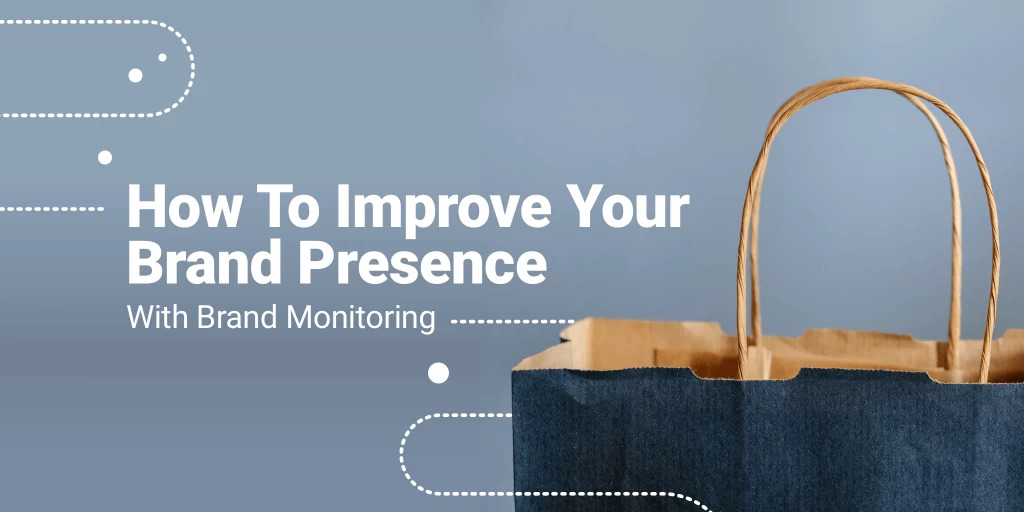How To Improve Your Brand Presence With Brand Monitoring?

It’s not an exaggeration to say a company’s online presence supersedes any other form of publicity and marketing strategies. Consumers have migrated onto online spaces to leave their impressions for all to see, source recommendations and warn each other off from bad brands.
A good brand presence on social media and other platforms improves overall brand reception and engages with the target audience in a meaningful way.
A partial benefit is securing repeat customers and boosting sales leads. But beyond this, there’s no price to a good reputation. It takes work, however, to get to a place where you’ve strengthened your relationship to your customers and cultivated good faith. Brand monitoring highlights those areas where you can improve.
What does brand monitoring mean and why does it matter?
Brand monitoring encompasses all monitoring activities centered around your brand, products and even industry, if you have ambitions to rise as the dominant force in your local market and product niche. It’s as simple as logging onto your social media profiles to glance over direct messages and tagged posts, or as wide-reaching as gathering data from social mentions over time and mentions on mediums such as online publications, reviews and news articles.
Brand monitoring should be in every company’s toolkit regardless of size or sector. Through brand monitoring you’re able to position your company within the context of your industry and then truly understand the relationship it has with its customer base. Knowing what’s being said about them, a company has the opportunity to react accordingly through changes in their marketing.
Truth of the matter is companies exist online first and offline second. Social sentiment determines your performance, trustworthiness and longevity.
Whoever controls the narrative controls the outcome.
Why do you need to monitor your brand online
Optics is everything in business right now and unlike the olden days whatever one puts on the web stays on the web for all eternity. Companies have no other course of action than to monitor online spaces and find out what people are saying about their brand and products.
Through this process companies gain insight into public attitude and are empowered to rehabilitate their image in due time before a negative reputation cements them at the bottom of the totem pole. Bad reputation sticks like tar and is a hard trap to escape.
In the long run, this means a hemorrhage in sales from repeat customers as well as a major dip in sale conversions. There are three major reasons why you need to get on this bandwagon and do it as soon as possible.
Manage your online presence
What a brand puts out online often feels separate from the overall marketing strategy or at the very least as an afterthought.
Some brands are only on social media in order to have the account names under their control, but without any activity. Others only post on their social media channels to push promotional links and run campaigns that don’t actually seem to be targeted at anyone.
Then there are those brands, which do post online but are random at best or completely divorced in tone from the rest of their messaging.
Brand monitoring bridges over social media with other branches of marketing, so you understand how to best approach your audience with an authentic voice. This extends to the type of content you post – yes, there has to be more than call to action – and how you interact with major topics of the day.
Communicate with your customers more effectively
Customer care does far more in the long run to instill brand loyalty than even the best product in the world. Multiple studies and reports have shown that a sensible, customer-first approach by brands is what keeps consumers happy and away from switching to a competitor.
As brand monitoring goes into tracking all company and product mentions on social media – both where you’ve been directly tagged and not (which is the case for the majority of discussions about a company on social media) – you’re constantly connected to your audience. Although you should definitely gather these data points and analyze the general sentiment, it’s also a good first step to reply back.
Companies who respond within minutes to an hour to their customers enjoy much higher customer satisfaction rates and an increase in repeat sales.
Follow the industry trends
Spotting industry trends before they truly catch on and taking advantage before your competitors pulls you ahead as a brand. Early adopters and pioneers not only boost their sales leads and sales numbers, but also generate prestige and are often remembered as ‘the first’. History rarely pays attention to those who came second.
Industry research influences how a company sells, what it sells and to whom it sells. We’re talking about big shifts in consumer behavior and groundbreaking technology. On a smaller scale, industry trend research reveals small pockets of opportunities. Perhaps it’s a consistently occurring period of seasonal high demand or it’s a specific geographic market.
How to efficiently monitor your brand online?
We’re going to break down the process behind brand monitoring in its core steps. Mind you, these are not in order and each brand monitoring strategy is going to have unique aspects and challenges.
However, we can say it’s these four steps that more or less guarantee successful monitoring over time. Still, it helps very much to think about the goal you’re trying to achieve at this moment in time. Are you working towards reinvigorating the brand? Did the last product launch fail and you want to understand why that happened? Is there a scandal you want to handle?
The motivation certainly aids you when you…
Choose the right set of branded and non-branded keywords
Keywords are the fuel powering your monitoring tool to do its job. Naturally, it should be the right fuel or else you’re throwing money to the wind without much of a return on interest.
Branded words are what every marketer starts with as they determine opinions and conversations about your company in real time. Pinpointing conversations about your brand, whether tagged or not, presents you with opportunities for engagement to either join in on the fun or perform damage control. Either way, they’re essential on the day-to-day marketing operations. Consider the brand name, slogans, product names, branded hashtags and campaign names along with types and any common misspellings.
Non-branded words assist in bigger scale marketing work as you explore your company’s standing in the context of your industry. Trend analysis is a powerful way to calibrate your efforts, though a more proactive approach would be to use non-branded keywords when building SEO links to improve your ranking and become more visible, and targeting PPC campaigns.
Look into social media
Chasing headlines and taking note of industry trends has its uses, but the big money is to be found in social media. For one, customers are now reliant on recommendations over social media whether that’s through a friend or the strong para-social relationships they have with trusted influencers.
On another note, social media data is public. Everything that a customer, who engages with your product, does is all available online, free of charge. With the right tool for data gathering and analysis you’re able to finely tune your next marketing efforts for maximum engagement and sales leads generation. Not to mention that proper social engagement is the best way to make repeat sales.
Brands are social constructs assigned personality and come alive on the Internet. Customers don’t want to engage with an automated answering machine or a sales representative over the phone – that’s a relic of the past. Airing of the grievances happens as well as compliments are brought online and it’s in your best interest to engage with the audience where they are. Not to mention, the digital trial they leave behind further fuels your customer research.
Track the industry and the competition
The competition is the industry is the competition. Yes, broader technological and consumer trends will come and go – definitely pay attention to those – but it’s your rivals that you should monitor as closely as your own company.
Competitors answer the question ‘what if’ – what if we ran such an ad? What if we didn’t respond frequently to our customers? What if we launched such a type of campaign? The answers give you signposts along the way to crafting your own marketing strategy and coordinate marketing efforts be it through re-designing a product or creating a certain type of content for social media.
The reason for the effectiveness of such monitoring lies in the overlap in audience between you and your rival. Yes, a slice of their demographic has chosen their company for a specific reason, but otherwise brand loyalty is fickle and what works for them can reasonably generate the same result. As an aside, you are bound to discover a lot more about the consumer psychology of your target customer and enrich your buyer persona models.
Find a good brand monitoring tool
Right – let’s talk tools! What you need. What you want. How to get it.
Brand monitoring requires a little more investment than simply performing monitoring on social media activity the way Hootsuite does. It’s a perfect tool to achieve better control over response times and improve customer communication, but you need a wider reach. RSS readers can help in monitoring brand mentions and follow industry news and trends. Inoreader performs amazingly as a tool for curation and advanced search. What it lacks is the ability to compile and report on data.
So the tool you need has to strike a fine balance and give its users full breadth of functions. The most versatile in terms of listening strategies on the market is Sprout Social, which adapts fully to whatever your company needs. One of the basic strategies on offer is brand health – a deep dive into perception of the brand alongside demographics, complaints and other comments made by your customers. It’s exactly what you need to understand how your company is viewed in greater detail.
If you want a super-powered tool and are ready to pay the price, then Talkwalker certainly gives you a bang for your buck. What’s so special about Talkwalker? On top of every expected feature we’ve discussed above from monitoring and analyzing posts on every social media platform this tool fully covers other online spaces. You’re able to extract data from blogs, news sites and even forums.


